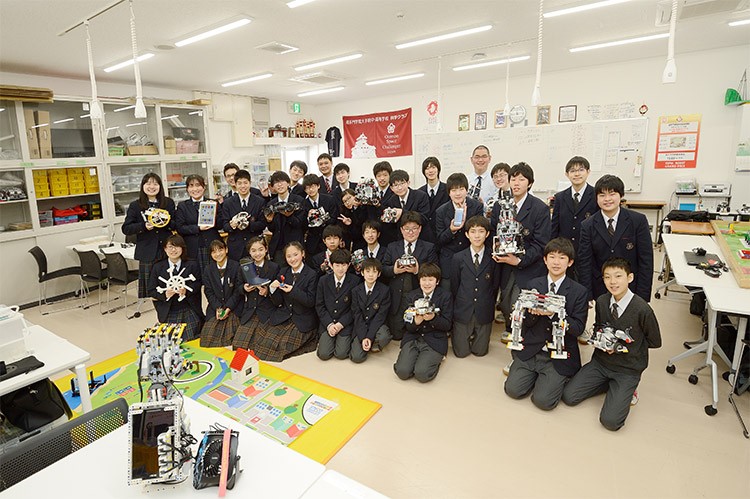
The Robot Science Club at the Otemon Gakuin Otemae School has gone beyond the boundaries of school club activities to realize many full-scale "robot projects." Their activities cover a wide spectrum, winning prizes at international robot contests, developing robots that solve social problems, and providing robotics education to local people. The students set their themes, work together to solve problems, and spread information, and outside parties have evaluated their efforts highly. The club has also registered for the "Co-Creation Challenge," a TEAM EXPO 2025 program promoted by the Japan Association for the 2025 World Exposition in preparation for Expo 2025, Osaka, Kansai, Japan. We will introduce the unique initiatives of these junior and senior high school students working to "create a better society through robot development."
Daring to challenge the world's top robotics contest
As we passed through the school's historic gates, a new prefab building was in stark contrast to Osaka Castle tower in front of us. Inside the building, about 30 students were working in groups. Some discussing their ideas, some looking at computer screens, and some making something with Lego blocks. We were in the "Tech Lab," the club room of the Otemon Gakuin Otemae Junior and Senior High School's robot science club.
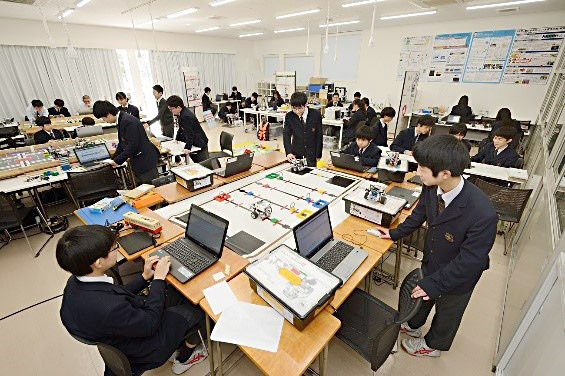
Up ahead, a robot made with "Lego Mindstorms" carried blocks of various colors. Watching it in earnest was a team of three people entering the WRO (World Robot Olympiad), an international contest for autonomous robots.
"We can't control the robot during a competition, so we have to program all the movements in advance," explained club member Nakamura, who is in charge of software. "It's difficult to build effective communication so that Nakamura can program," said another member, to whom Nakamura replied, "Because I'm asking too much." Another different member cuts in, "We do fight sometimes." Exchanges such as this showed us the good teamwork of those who aim to make a better robot. "This year, we want to win first place at the WRO Japan and go to the International Final," ― I felt the quiet confidence in their words.
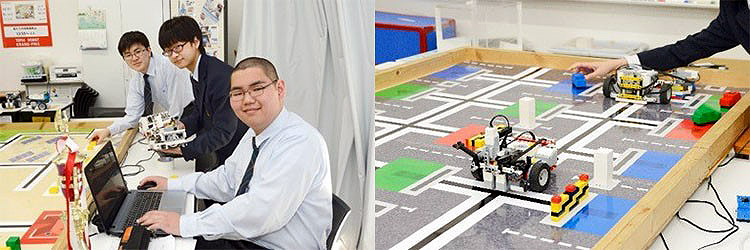
An advanced guide-dog robot that has inherited the technology of their predecessors
Right behind the WRO team, a miniature "city" with features resembling a hospital, traffic lights, and roads was built, and a dog-shaped robot was sitting on top of it. "It's a guide dog robot called 'Ai-dog*,'" said Furumoto, in charge of information sharing for the team. "Currently, about 3,000 people in Japan need guide dogs, but there are less than 1,000 available guide dogs. We have developed this robot to solve the problem."
After being activated, Ai-dog asked me, "From where to where do you want to go?" I answered, "From my house to the supermarket," then it began to move. It ran autonomously, following the Braille blocks embedded in the road, bypassed obstacles, stopped at a red light, and proceeded again at a green light. When it reached its destination, it wagged its tail and it stopped.
Ai-dog is the second model, taking over and improving the first model made by their predecessors. The tires are bigger to go over level differences, the signal recognition rate increased, and the total size is smaller. A quadrupedal robot that can climb stairs is also under development for testing on public roads shortly. Furumoto concluded her demonstration by saying, "We aim to create a society where everyone can smile."

* The name of "Ai-dog" is derived from the meaning of supporting the owner's eyes and being close to the heart to support the mental aspect (i.e., "love" in Japanese).
IoT power strips contribute to relieving climate change issues
Two more club members, Iga and Minakata have developed an IoT power tap that remotely controls the power switch and the output to prevent electricity waste. Minakata gave us a demonstration of controlling the air volume of a fan connected to the tap.
For the theme of "climate change," the two students discussed how to solve the problem many times with their advisor, Fukuda-sensei (teacher). Iga, who had little experience in robot development, was initially like, "I have absolutely no idea what Minakata is saying" "But I made this after doing my research, understanding the words, and thinking about how I could get them across better." She pointed to the poster that outlines the development in an easy-to-understand manner.
On the other hand, Minakata, who has a wealth of experience in robot development, says that he was surprisingly "gloomy" as a junior high school student. As he developed robots, he gradually gained confidence in his skills. "I think I was able to grow up looking at my seniors, who told me that I was 'better than they were'," he said, looking a little embarrassed.
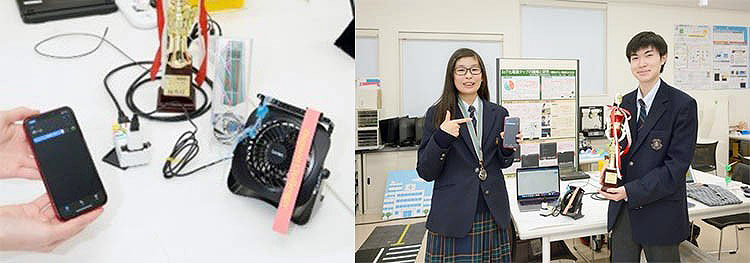
Sharing information at SDGs seminars using robots
The team lead by Yamamoto, the club manager, has been working on the planning and managing of "Save Our Earth," a seminar to think about the SDGs and global environmental issues through robots. The large diorama on the floor is a model expressing various environmental problems. Seminar participants can operate robots on this model and learn about environmental issues by turning off the lights in the houses, separating plastic bottles from empty cans, removing garbage from the ocean to clean it while having fun.
The members who created the model said they had a hard time making the design easy to understand and enjoyable for the participants. "This time, we tried to build the robot with just a 'push' action. Children were like 'Oh!' when they saw the house lights go off with the 'push' button." The members who spoke also seemed to have enjoyed running the seminar.
Participants are not only from Osaka but also from neighboring areas. Yamamoto said that it was essential to spread their activities, not just to develop things. She would like to continue developing programming materials and sharing information after going to university. Miyagawa, the deputy club manager, expressed his thoughts on the future, saying, "There used to be nothing that interested me, but now I hope to get a job where I can use my strengths through programming."
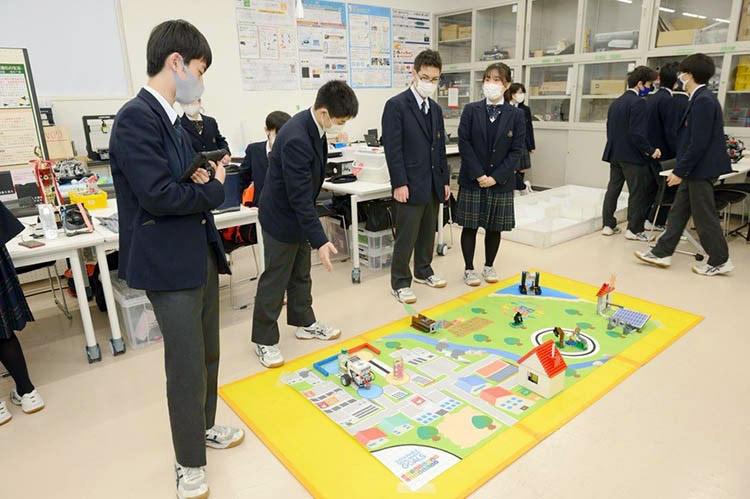
RoboCup Junior Disaster-Relief Robots Compete over using Practical Technology
One robot moves around the maze-like field. Surrounding it are students trying "the RoboCup Junior Rescue Maze." The maze resembled a disaster area, and the competition is to deliver relief supplies to victims as quickly as possible. The shape of the maze changes each time, and obstacles resembling rubble are placed randomly. "We program the maze through trial and error so that participants can pass through any field," said a member in charge of software. "The appeal of this project is that you can be of use to society while learning technologies."
The only junior high student (2nd grade) in a senior high team, Fujimura, talked about the charm of cross-grade interaction. "I can absorb things from senior students ― things that I wouldn't understand if I were with students of the same grade." At first, he was unsure of what to expect, but he gradually became closer to them as he worked with his seniors. Egawa, the team leader, added, "It is an education method in which seniors teach juniors instead of teachers."
Over in RoboCup Junior, where the competition is in practical technology, Otemon has many strong rival schools. "Schools that have processing facilities can build full-scale metal robots. We can't beat them with power (equipment), so we compete with programming (knowledge)." In his remarks, we could feel his pride and belief that he would not lose to them with software.
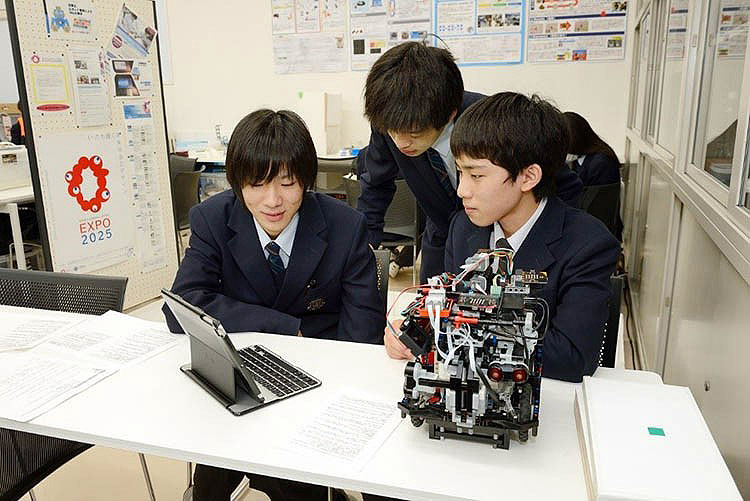
Oil spill recovery robot developed in collaboration with a private company
At the back of the room, a pure white machine caught our eyes. It looked like a water wheel, different from other Lego robots. It was an oil spill recovery robot developed by Egawa and Kuratomi. Kuratomi said, "We started developing this robot after the oil spill accident in Mauritius." The idea of recovering oil spills by combining water purification agents manufactured by a company they met through club activities and robot technology was born.
The mechanical model the two students invented, the "pure white water wheel," was prototyped using a 3D printer. To get prototype funds, they applied for a grant from a foundation that supports technological development. "It's not unusual to look for supporters by ourselves," said Egawa. "Fukuda-sensei also tries to look for one for us, but basically, we do it ourselves and give a presentation to potential supporters."

What I'm most happy about is seeing my students grow
During the interview, the advisor, Fukuda-sensei, left all the explanations to the students and never cut in. The students also spoke freely and conveyed their initiatives in their own words. Fukuda said, "The students who participate in the competitions give electrifying presentations." But, he added, many of them wanted to join an athletic club but couldn't or are a little withdrawn. "I am most happy when I see these children grow up and the lights switches on in them. That's what keeps me doing this job," he smiled.
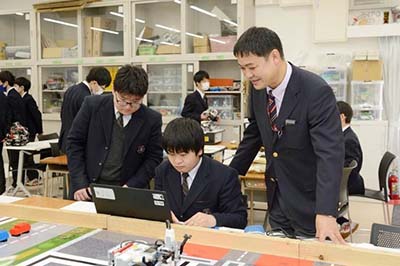
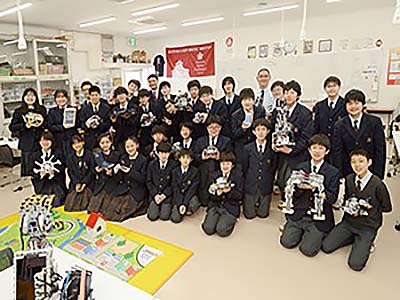
The club started in April 2014 with six members from junior and senior high schools and teacher Tetsuya Fukuda as an advisor. In 2020, the club registered for the "Co-Creation Challenge," a TEAM EXPO 2025 program, with a "robot development project for solving SDGs by young people in Osaka."
■ A video of the clubs' "WRO2019 Otemon Challenger" (Advanced Marine Debris Recovery Robot) presentation can be seen at the following link(YouTube): https://www.youtube.com/watch?v=21R_0-SNZ8s
Original article was provided by the Science Portal and has been translated by Science Japan.




